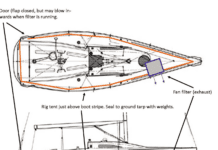Sometime around 2.4 million years ago, the first hammer was created. It may have been used to crack a piece of bone for supper or deliver the death knell to a rival suitor, but my guess is that it probably ended up smashing its discoverer’s digits.
After so many bruised knuckles, some bright cave-dweller decided to lash a short piece of wood to the mass, allowing him to increase the velocity of the head and deliver a more powerful blow without getting hurt.
Seaside dwellers had a natural hammer at their disposal: A large whelk washed by the surf eventually assumes a hammer-like form. If you explore the shell middens of Southwest Florida, you can find polished implements dating back 3,000 years. This basic design served humans well, at least until hardwood nails entered the scene, putting thumbs in the line of fire.
While metalworking technology brought more potent hammers, with heavier masses and stronger shafts, these tools really haven’t changed much since the Iron Age. They are big, blunt objects made for banging.
Simple but effective, hammers have long fascinated me. They are the Shivas of the tool pantheon—as good at destroying as they are creating.
I was thinking of hammers this month after sorting through the collection of broken gear sent to us by our loyal readers. (See “Gear Graveyard,” page 21.) The forlorn assemblage of bits and pieces brought a bit of cheer to winter as I realized that you and I are very much alike. We are passionate about sailing, careful about the equipment we put on board, and are easily enraged when the gear doesn’t live up to our standards. This might explain another common trait I noticed: Hammers don’t belong in our hands-at least not while we are aboard our boats.
Cruising necessarily involves fixing things, and fixing things requires tools, but a 24-ounce framing hammer is not something a sailor should resort to often. A wooden mallet is the proper sailors tool for banging-
invaluable for caulking a seam, chiseling a dovetail, or rolling a splice. But a heavy claw hammer will surely wreak havoc on a boat.
About three years into our Pacific cruise, the true dangers of having a hammer onboard became clear to me. By then, a pattern had developed. Something would break. Id try to fix it, and when all else failed, I’d reach for the hammer. Whenever this happened, all hope was lost. Nothing would be repaired at the business end of the tool. I would be feeling the impact (no pun intended) of its blow for days, or even months to come.
Ultimately, my long-suffering partner would pick up the pieces of whatever I’d destroyed, while I stormed around the boat cursing some piece of equipment that couldn’t survive the lethal combination of my own neglect, ignorance, and impatience. Oh yes, and a mighty blow from a hammer.
So, in the hopes of saving the thumbs, knuckles, and marriages of like-minded folks, I offer this:
A hammer wont revive a seized outboard or restore a waterlogged VHF. Its of little use repairing a laptop, a bilge pump, or leaky plumbing. A hammer should never be matched with snatch blocks, digital cameras, or linkages on wind vanes. In fact, if you can avoid using a hammer altogether, you will no doubt have fewer regrets in the years ahead. At the very least, all of your digits will be intact.
Darrell Nicholson,
Editor



































